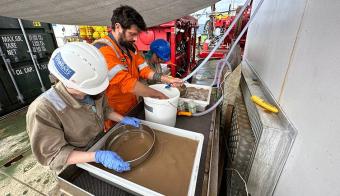- First comprehensive checklist of life in the Clarion-Clipperton Zone compiled
- Over 90% of species in one of the most likely future mining sites are undescribed by science
- The paper How many metazoan species live in the world’s largest mineral exploration region? is published in Current Biology
In a new paper led by the Natural History Museum (NHM), researchers report on the life of the Clarion-Clipperton Zone (CCZ). A rapid growth in taxonomic surveys for the area which began in the early 1970’s has allowed them to conduct the first comprehensive synthesis of CCZ biodiversity and create an inventory vital to future assessments of environmental impacts from any mining activity.
The CCZ is an area of the deep sea spanning up to six million km2 roughly the width of the continental United States between Hawaii and Mexico and it alone currently has 17 contracts for mineral exploration covering 1.2 million km2. However, despite initial mineral exploration beginning in the 1960’s, baseline biodiversity knowledge of the region has been severely lacking until recently.
Dr Tammy Horton at the NOC, one of the co-authors of the study, said, “We have been studying the biodiversity of the CCZ in collaboration with the NHM team for many years, and this study represents a major advance in our knowledge of the biodiversity of the region."
Co-author Dr Daniel Jones at the NOC, highlighted, “With deep-sea mining being considered in the area, it is incredibly important that the unique and biodiverse deep-sea animals of this area are better documented. The records of these animals comes primarily from deep-sea research expeditions, such as our recent SMARTEX expedition to the CCZ. In these rare opportunities to visit the remote CCZ we catch a glimpse of the diversity of life in this vast environment, for example using robotic submarines to photograph, study and collect some of the fascinating animals.”
Data from such cruises made up some of the 100,000 records that the team analysed to help them understand life in the CCZ. Notably an increase in biological recording was seen with most species described in recent years. The compiled checklist resulted in 27 phyla, 49 classes, 163 orders, 501 families and 1119 genera in total. On a species level the team recorded 185 and only six of them, namely the sea cucumbers, have been recorded elsewhere meaning they are likely unique to the CCZ.
Co-author Erik Simon-Lledó at NOC added, “The majority of species recorded were Arthropods such as shrimp or crabs with Annelids and Nematoda groups, which include various worms, also making up many of the species counted.”
The recent increase in biological data available to the team is partly due to efforts by The International Seabed Authority (ISA). They have ensured that, as part of explorations for potential mining, companies must collect and share environmental data. This data is then shared publicly by ISA through their DeepData platform.
Author, Muriel Rabone, at the NHM, explains, "DeepData is one of the tools that has significantly increased our knowledge of the CCZ, but we would still predict there are 6,000–8,000 more unknown animal species meaning around 90% of species in the CCZ are not known to science.
"We should note that the percentage of undescribed species in this zone is similar to that recorded for the global ocean but the potential for mineral extraction in this area means we should strive for a better understanding of the life it holds."
The study also revealed that some regions of the CCZ have barely been studied at all. The least sampled sites being rocky outcrops which have been shown to have unique and diverse communities and so would benefit from a more in-depth understanding. Work at NOC has already started revealing more about these, but more work is needed.
The team behind the research hope that this CCZ checklist is a key step forward towards creating field guides for the area’s wildlife. The estimates they provide can create a starting point for future data collection as new methods become available allowing us to truly understand this environment and how we may impact it.
Given that mining operations in the area could be imminent with ISA considering applications this year, the use of biological data for environmental management has become more important than ever.
This work, part of a UN Ocean Decade Action Project, supports our mission to give people the opportunity, the ability, and the motivation to protect, restore, and harness the value of our ocean.

